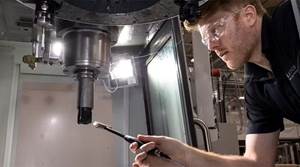The Personal Waterjet Cutting System Is a Natural Development
Much like what is happening with desktop 3D printing, Omax has developed a way to bring the versatility, capability and simplicity of waterjet cutting to a broader spectrum of users.
Share





Perhaps no other material cutting process is as versatile, capable and simple as abrasive waterjet cutting. These qualities have made it a favorite for industrial users such as job shops and fabricators as well as for mobile repair centers, engineering classrooms, art studios and design houses. In an effort to make the technology even more versatile, Omax has now announced the release of a personal waterjet cutting system called the ProtoMax.
This system promises to make waterjet cutting feasible for a broad class of users for which versatility, capability, simplicity (and now affordability) are especially important. This group includes inventors, artists, teachers, engineers, prototypers, hobbyists, crafters and industrial users who need occasional waterjet capabilities to complement other cutting systems. The ProtoMax would not be out of place in a household setting. In fact, many of the same types of users who have already embraced various 3D printing and additive manufacturing processes in the maker movement are likely to take note of this new system.
Omax describes the new waterjet as a compact, self-installed cutting system suited for prototyping and relatively low-volume cutting of almost any material less than 2 inches thick in two-dimensional contouring. Aluminum, steel, composites, rubber, glass, granite, plastics, wood and other materials can be cut under the 30,000-psi cutting nozzle powered by a 5-hp pump. The maximum workpiece size is 12 inches by 12 inches. Abrasive waterjet cutting does not create a heat-affected zone, does not change material properties, creates little mist, and is relatively quiet at 76 decibels when cutting under water (about the same noise level as a garbage disposal or dishwasher). Other specs given for the ProtoMax include ±0.005-inch linear positioning accuracy, ±0.003-inch repeatability and a maximum 100-ipm traverse speed.
The system accepts the same garnet powder used in full-scale industrial systems. Because the garnet powder is available in proportionately smaller quantities appropriate for a unit of this size, the price per pound is somewhat higher. The hopper of the unit holds 14 pounds of powder. The lower stream pressure of the new system does reduce cutting speed compared to full-size machines, but this does not seem an obstacle for projects that fit the cutting table of the personal system.
The new waterjet plugs into a three-prong, 240-volt AC outlet such as one used for a home clothes dryer. The pump and cutting table are on casters, enabling the unit to be rolled into place.
As is the case for industrial models of abrasive waterjet cutting machines, programming software and the unit’s computer control system largely determine how readily the process can be implemented. For the ProtoMax, part programming and cutting operations are controlled by the company’s proprietary Intelli-Max software. According to Stephen Bruner, VP of marketing, the ProtoMax programming and control software are based on the same CAD/CAM software features of the industrial version. These features include waterjet cutting models that predict the behavior when cutting different materials, thicknesses and shapes. The user interface is said to be straightforward and appropriate for learning computer-aided manufacturing.
Mr. Bruner also notes that whereas most small industrial waterjets start at $70,000, the ProtoMax has a unit list price of $19,950.
to provide additional information about the personal waterjet system and purchasing options. The site includes design ideas, detailed specifications, frequently asked questions and a community section to support users and fellow enthusiasts. The first units are expected to be shipped by the end of 2017.
Related Content
How to Mitigate Chatter to Boost Machining Rates
There are usually better solutions to chatter than just reducing the feed rate. Through vibration analysis, the chatter problem can be solved, enabling much higher metal removal rates, better quality and longer tool life.
Read MoreOrthopedic Event Discusses Manufacturing Strategies
At the seminar, representatives from multiple companies discussed strategies for making orthopedic devices accurately and efficiently.
Read More4 Commonly Misapplied CNC Features
Misapplication of these important CNC features will result in wasted time, wasted or duplicated effort and/or wasted material.
Read MoreQuick-Change Tool Heads Reduce Setup on Swiss-Type Turning Centers
This new quick-change tooling system enables shops to get more production from their Swiss turning centers through reduced tool setup time and matches the performance of a solid tool.
Read MoreRead Next
Last Chance! 2025 Top Shops Benchmarking Survey Still Open Through April 30
Don’t miss out! 91ÊÓƵÍøÕ¾ÎÛ's Top Shops Benchmarking Survey is still open — but not for long. This is your last chance to a receive free, customized benchmarking report that includes actionable feedback across several shopfloor and business metrics.
Read MoreAMRs Are Moving Into Manufacturing: 4 Considerations for Implementation
AMRs can provide a flexible, easy-to-use automation platform so long as manufacturers choose a suitable task and prepare their facilities.
Read MoreMachine Shop MBA
Making Chips and 91ÊÓƵÍøÕ¾ÎÛ are teaming up for a new podcast series called Machine Shop MBA—designed to help manufacturers measure their success against the industry’s best. Through the lens of the Top Shops benchmarking program, the series explores the KPIs that set high-performing shops apart, from machine utilization and first-pass yield to employee engagement and revenue per employee.
Read More






















